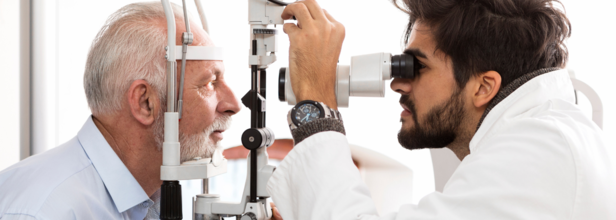- Health Conditions A-Z
- Health & Wellness
- Nutrition
- Fitness
- Health News
- Ayurveda
- Videos
- Medicine A-Z
- Parenting
Can You Detect Dementia With An Eye Test?

Dementia. It is a brain condition that causes loss of cognitive function, which includes thinking, remembering and reasoning. It can also affect a person's ability to perform daily activities. It is a progressive neurological condition, which means the ability to communicate, or to perform cognitively deteriorates with time. You can delay the deterioration, but cannot stop it. But how does one delay the progress without knowing that it is happening? Well now, this can be achieved as Scottish researchers are working on a new AI tool that uses high-street opticians to spot early signs of dementia.
Now, dementia can be diagnosed through an eye test.
AI, Eye Test, And Dementia
Scottish scientists from the NeurEye research team have found that photographs taken of the retina at the back of the eye can indicate of brain health. It is done using AI software to analyze the information. Scientists also use this to spot signs of diseases before any symptoms are even experienced.
The team of scientists has collected a million eye scans from opticians across Scotland, which is also the largest data set of this kind. With the help of AI, they have developed an algorithm that can assess the health of the blood vessels in the eye that indicates neurogenerative diseases.
The database built by the team can be applied to photographs taken during routine eye checkups and could be used by clinicians to prevent diseases from occurring. It could also help them in diagnosing conditions at an earlier stage than what they currently can.
How It Works?
The blood vessels in the eye are small and fine, which means they show up conditions earlier than any other part of our body. Balijean Dhillon, who is part of the research group led by the University of Edinburg and researchers from Glasgow Caledonian University said that eyes can reveal more than was thought possible.
All the systems of the body are represented in eye. In fact, the diseases like cataracts, glaucoma, macular degeneration, problem with vision could also detect vascular system, heart health, high blood pressure, diabetes and even neurological conditions. While some of these conditions may show up late, eye care can detect it way before. The earlier you find it, the better it is for you to be able to delay the deterioration.
What Is Dementia?
Dementia is an umbrella term to describe diseases that cause people to lose their cognitive functions. These diseases gradually progress decreasing the ability for someone to function in daily life and take care of themselves. There are some medications used to delay the onset of it and to manage it. People can reduce the chances of developing it by following a healthy diet and lifestyle.
Types of Dementia
Different types of dementia occur due to different reasons. Some types of this disease are:
Alzheimer’s Disease
Alzheimer’s disease occurs when two abnormal proteins (tau and amyloid protein) build up in the brain. Some of its diseases include mental confusion, short-term memory loss, and personality and behaviour changes. In later stages, people may start having trouble talking, recalling distant memories and have issues with walking.
Vascular Dementia
Vascular dementia may occur because of a stroke or atherosclerosis. Atherosclerosis is the hardening of the arteries from plaque building up gradually inside of them. It blocks and damages blood vessels in the brain. This disease has symptoms such as memory problems, confusion, concentration problems and difficulty in completing tasks.
Mixed Dementia
Mixed dementia is a combination of two or more types of the disease. Sometimes, Alzheimer’s disease combined with vascular dementia causes mixed dementia. The health condition usually declines faster in people with mixed dementia than those who only have one type.
Huntington’s Disease
A mutation in the huntingtin(HTT) gene causes a breakdown in the brain’s nerve cells and it is responsible for Huntington’s. This disease causes body movement control problems, trouble thinking, decision-making, memory trouble and personality changes.
Traumatic Brain Injury
Someone may develop dementia-like symptoms if they suffer from repeated physical trauma to their head. Symptoms may appear after a long time and may include memory loss, behaviour or mood changes, slurred speech and headaches.
Parkinson’s Disease
People who have Parkinson's disease may develop secondary dementia in the later stages. Some of its symptoms are having trouble with thinking or speaking. Patients may have hallucinations and delusions, or suffer from depression.
Normal Pressure Hydrocephalus(NPH)
When Cerebrospinal Fluid(CSF) builds up in the brain’s ventricles the excess build-up harms the brain and this causes Normal Pressure Hydrocephalus(NPH). A brain infection, brain injury, bleeding in the brain or any previous brain surgery can also cause this condition.
This disease has some symptoms such as poor balance, forgetfulness, and short attention span, loss of bladder control, frequent falls and mood swings.
Infections
Some infections such as HIV infection, syphilis as well as Lyme disease can cause dementia-like symptoms. Urinary Tract Infections or UTIs, and lung infections can cause symptoms that match dementia.
Central Nervous infections and brain infections can cause cognitive symptoms. Also, COVID-19 symptoms include acute delirium or brain fog.
Taking Statins Or Amlodipine? UK Health Experts Issue New Medication Warning

Credits: Canva
Millions of people across the UK who take certain everyday medicines are being warned by the NHS to steer clear of a specific fruit. Health officials say combining this fruit or its juice with some medications can trigger serious reactions and unexpected side effects. The advice applies to patients prescribed some of the most commonly used drugs in the country, including certain statins, amlodipine, and medicines for anxiety. Statins, in particular, are widely prescribed to help reduce levels of “bad” LDL cholesterol in the blood.
Why Statins Are Commonly Prescribed?
Statins work by limiting how much cholesterol the liver makes. This helps slow down the build-up of fatty deposits inside the arteries, which in turn lowers the risk of heart attacks and strokes. Doctors prescribe statins both to manage high cholesterol and to prevent future heart-related problems. For most people, they are taken daily as tablets and are often part of long-term treatment.
What Does Amlodipine Do?
Amlodipine, commonly sold under the brand name Istin, belongs to a group of medicines known as calcium channel blockers. It is mainly used to treat high blood pressure. For people with hypertension, amlodipine can reduce strain on the heart and lower the risk of serious complications such as heart disease, heart attacks, and strokes.
NHS Warning On Statins Or Amlodipine
Patients taking certain forms of amlodipine, particularly calcium channel blockers, are advised not to consume grapefruit. The NHS website clearly states: “Do not take amlodipine with grapefruit juice.”
The reason lies in how grapefruit affects the body. It interferes with enzymes and transport proteins in the gut, such as CYP3A4 and P-gp, which normally help break down medicines and control how much enters the bloodstream. When these processes are blocked, higher-than-intended amounts of the drug can build up in the body, increasing the risk of side effects.
What Patients Should Keep In Mind
Not every medicine reacts the same way to grapefruit juice, which is why doctors advise checking before making changes. Always speak to your GP or pharmacist, read the information leaflet that comes with your medicine, and look out for any warnings related to grapefruit.
It is also important to understand that simply spacing the fruit and the medicine apart is not enough. In most cases, grapefruit should be avoided entirely for as long as you are on the medication, unless your doctor says otherwise. Patients are also encouraged to be cautious with other citrus fruits, such as Seville oranges, pomelos, and limes, as they can have similar effects on how medicines work.
What To Do If You’ve Already Consumed It?
If you have eaten grapefruit or had its juice while taking statins, amlodipine, or anti-anxiety medication, there is no need to panic. In many cases, a single exposure does not lead to serious harm, but it is important to stay alert. Pay attention to how your body feels over the next day or two, especially if you notice symptoms such as dizziness, muscle pain, unusual tiredness, nausea, flushing, or a sudden drop in blood pressure.
Do not stop taking your medication on your own. Skipping doses or stopping treatment abruptly can be risky, particularly for heart and blood pressure medicines. Instead, make a note of what you consumed and when, and contact your GP or pharmacist for advice. They can tell you whether any action is needed based on the specific drug, dose, and your overall health.
Holiday Heart Syndrome Explained: Causes, Symptoms, And How To Stay Safe

Credits: Canva
During the festive months, overindulgence in celebrations can trigger holiday heart syndrome (HHS), a potentially serious yet largely preventable set of heart-related symptoms that tend to rise during this time of year. Most people recover within a day, but HHS can occasionally lead to stroke, heart attack, or other serious complications, according to the Cleveland Clinic. As the holiday season approaches, let’s explore what holiday heart syndrome is, its symptoms, and how to prevent it.
What Is Holiday Heart Syndrome?
First identified by a US physician in 1978, holiday heart syndrome describes irregular heartbeats that occur after binge drinking during the festive season. Research from the University of South Australia shows that alcohol consumption increases by 70 per cent in December compared to other months, while iSelect data predicts Australians may consume around 58 million standard drinks per day during the month. With numbers like these, some caution is warranted.
Atrial fibrillation (AFib) is the specific irregular heartbeat seen in HHS. It occurs when the heart’s upper chambers contract or quiver in a chaotic pattern, which can cause blood to pool in the atrium and form clots. If these clots enter the bloodstream, they can travel to the brain and trigger a stroke.
What Are the Symptoms of Holiday Heart?
Symptoms can include fatigue, dizziness, shortness of breath, anxiety, weakness, confusion, sweating, faintness, unusual tiredness during exercise, rapid or irregular heartbeat, and sensations like fluttering, thumping, pressure, or chest pain.
Dr Mariann R. Piano, Nancy and Hilliard Travis Professor of Nursing at Vanderbilt University School of Nursing, warns, “The scary thing is that people may not notice any symptoms, which makes it a particularly dangerous arrhythmia.”
How Can Drinking Lead to AFib?
Researchers are still investigating exactly how alcohol triggers AFib and how much intake increases the risk. A 2020 study found that people who usually drank at least 10 alcoholic beverages a week lowered their risk of holiday heart syndrome by reducing alcohol consumption. Another study confirmed that eliminating alcohol significantly decreases the chances of developing AFib.
How To Try to Avoid Holiday Heart Syndrome
The Australian Alcohol Guidelines recommend that healthy adults limit alcohol to no more than 10 standard drinks per week to reduce risk.
Experts like Kistler suggest that people with existing heart arrhythmias either abstain or stick to “up to three standard drinks a week.” Drinking mindfully, reducing overall consumption, and staying well hydrated can also help protect your heart.
Tips To Keep Your Heart Healthy During Holidays
Here are some practical ways to protect your heart during the festive season:- Eat smaller, balanced meals and avoid heavy late-night feasts.
- Limit alcohol intake and stay hydrated.
- Continue regular medications without interruption.
- Stay warm and avoid sudden exposure to cold temperatures.
- Maintain light physical activity and avoid strenuous exertion in the early morning.
- Manage stress by taking breaks, sleeping adequately, and avoiding overexertion during travel or celebrations.
- Seek medical help immediately if you experience chest discomfort, unusual fatigue, breathlessness, or palpitations.
Your Rights When You Feel Sexually Exploited By Your Doctor - Explained!

Credits: Gemini
Walking into a clinic or diagnostic centre is never easy. You carry your worries, discomfort, or questions, hoping the people there will guide you with care. Most medical professionals honour that trust. But when someone crosses a line—when a touch feels sexual, unnecessary, or wrong, the sense of safety disappears instantly. It’s not just awkwardness; it’s a violation in a place where you should feel protected.
A recent case in Bengaluru shows just how real this is. A radiologist at a private diagnostic centre was booked for allegedly sexually harassing a woman during a routine scan. When she spoke up, he reportedly threatened her and used abusive language to intimidate her. She had come for an abdominal scan with her husband, expecting a routine procedure, not harassment.
What stays with you after such an experience is not just the shock, it’s the feeling that your trust has been broken. That moment cannot be taken back. What you can do, however, is make sure the system is held accountable, so no one else has to face the same harm.
This raises an important question. Are there legal protections in India that support patients in such situations? To understand this better, we spoke with Anisha Mathur, Founding Partner at Shepherd Law Associates.
What Does India’s New Criminal Law Say?
India’s updated criminal code, the Bharatiya Nyaya Sanhita (BNS), which replaces the Indian Penal Code, is clear that sexual misconduct is a crime no matter where it occurs. Clinics, nursing homes, physiotherapy rooms, diagnostic centers, and even home-based procedure spaces fall under its scope. If a staff member touches a patient in a way that is not medically necessary, ignores privacy during an intimate examination, makes the patient feel uncomfortable, or reveals sexual intent, the act may be treated as a criminal offence.
According to Anisha Mathur, “Unwanted or unnecessary touch can amount to sexual harassment. Any contact that has sexual intent and is not medically justified may be treated as assault with sexual intent. The context, the nature of the procedure and the patient’s consent are all considered while determining this. A medical setting is not a loophole. A uniform is not immunity. Misconduct is misconduct.”
Actions To Take When A Sexual Misconduct Takes Place In A Medical Setting
Once you recognise that the behaviour is inappropriate, you have every right to act. Anisha Mathur suggests the following steps:
Step 1: Pause the interaction
Say you want the procedure to stop. You may ask for a female attendant or any other staff member to be present.
Step 2: Move to a safer area
Walk to the waiting room or any open space within the facility.
Step 3: Note down details
Record the time, the room, what happened and who was involved. Even small details may matter later.
In a larger hospital or diagnostic chain, go to the administration or patient desk and request that your complaint be put in writing. Many such establishments have an Internal Committee (IC) under the Prevention of Sexual Harassment (PoSH) Act, 2013.
If you are in a smaller clinic, nursing home or any space without a complaint system, call 100 or 112. When the officials arrive, ask them to record your statement. If you can reach a lawyer, it helps, because early legal guidance prevents confusion and intimidation.
Anisha adds, “Authorities may ask whether you want a Medico-Legal Certificate (MLC) examination to document physical signs, which is normal. You can request a trusted friend or family member to be with you. You do not need to know the law in that moment. You only need to protect yourself, the law will support you. If something feels wrong, it is wrong. You are allowed to stop the procedure immediately.”
Legal Actions You Can Take After the Incident
Once the initial shock settles, several routes are available:
• Filing a criminal complaint (FIR)
• Requesting disciplinary action from the medical council
• Filing a civil or consumer case if the establishment failed in its duty
Anisha Mathur stresses that both the individual staff member and the institution can be held responsible. This is often how meaningful change begins.
Can a Patient File a Complaint Anonymously?
In many hospitals and clinics, internal systems allow anonymous complaints. For police cases, your identity is needed for investigation, but Indian law protects your privacy strictly. Your name cannot be disclosed publicly. Any attempt to threaten or silence you becomes a separate offence.
Are Hospitals Expected To Have Safety Measures For Patients?
Every medical facility is expected to follow basic standards that protect patients. According to Anisha, these include:
• Clear consent before intimate examinations
• A female attendant upon request
• Privacy safeguards during procedures
• Staff training on professional boundaries
• A channel for patients to raise concerns
If these were ignored or missing, it strengthens the patient’s case. These protections are not optional. They are part of the provider’s legal duty.
Consequences For Staff Who Violate Boundaries
Sexual misconduct by medical staff is treated as seriously as misconduct in any other setting, sometimes more so because patients are vulnerable and rely on the professional’s judgment. Anisha explains, “Under BNS, the staff member can face criminal prosecution leading to arrest, fines, suspension or dismissal, and loss of professional license. Courts have repeatedly said that misusing power in a caregiving role makes the offence more serious, not less.”
Being in a medical space should never turn into an experience marked by fear. Any form of sexual misconduct during care is a violation of your dignity at a moment when you are already exposed and trusting. What happened cannot be undone.
Anisha Mathur stresses this and says, “Your voice can bring accountability. Your action can protect someone else. Your dignity remains yours, and the law stands with you.”
© 2024 Bennett, Coleman & Company Limited

